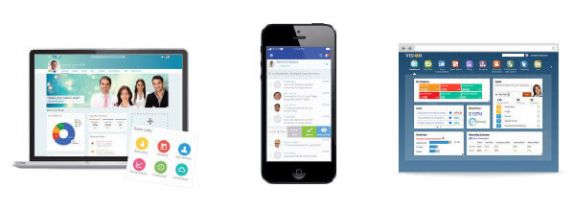Modern consumer applications are engaging and easy to use. Leading brands like Facebook and Uber devote huge budgets to ensuring their user experience outrivals competitor apps and meets customer demand.
If these applications fail to innovate their user experience continually, they risk losing consumers – and with them, revenue. The battle to create the most attractive, intuitive app has raised the user experience bar.
At home, a user is a consumer; at work, he or she is an employee – and their expectations, when it comes to the usability of technology, are no different in the workplace than anywhere else.
Where are we now with UX for the Enterprise?
‘Enterprise’ applications are under the same usability pressures as ‘consumer’ applications. Modern businesses depend on them for collecting and organising the large amounts of data that allow them to make strategic business decisions.
But employees are now demanding access to technologies that are flexible, accessible and user friendly. So, enterprise applications must up their game, when it comes to usability, if they are going to continue to deliver what the business needs. Traditionally, enterprise applications, like Oracle E-Business Suite HCM have neglected to put usability first, but it has now become a key challenge that business and IT leaders realise they must address.
This is reflected in Sierra Cedar’s 2016-2017 HR Systems Survey, which found that 71% of users reported Oracle E-Business Suite to have “a poor user experience.” 66% of the organisations who gave their vendors a low satisfaction rating, in this survey, also identified “poor user experience” as their primary reason for doing so.
This was a 40% increase on previous years – an upsurge likely due to the rising consumer (and therefore employee) expectations for user experience. As Stacey Harris and Erin Spencer put it: “Employees are becoming consumers of HR services and HR is seeing a shift in its role from administrator to service provider” (Sierra Cedar, 2016-2017, HR Systems Survey).
There is no question that businesses must address and respond to this shift. Organisations rely on employees engaging with enterprise applications, to collect the data needed to make strategic business decisions. Timely and accurate absence and holiday tracking, for example, is crucial to any HR or payroll department, which relies on this information for accurate payment. Information like this empowers businesses to know their workforce better, to make operational changes, if required, and to respond quickly to legislative changes.
Driving user adoption wherever you are on your Oracle journey
Applications, like Oracle E-Business Suite HCM, were designed to provide businesses with important data – but they need to be used if they are going to deliver that critical information. For organisations looking to get the most out of their HR technology investments, and increase employee adoption of these applications, improving the user experience is a critical first step.
Depending on where you are on your Oracle journey, you will have different options available to you. For example, there are some organisations that have made an investment in Oracle E-Business Suite with the view that it will underpin their business for the foreseeable future. These organisations can look to new technologies, which sit on top of applications to improve their usability. There are also those organisations that are ready and eager to embrace the latest in enterprise application software, deployed in Oracle’s cloud.

New technologies for improved UX
One way to improve the user experience, and therefore, the user engagement, is through specialised software, which sits on top of Oracle E-Business Suite applications.
By way of example, Applaud Solutions works in this way to add a modern, fresh and intuitive user interface to Oracle E-Business Suite. This is complemented by native mobile and tablet applications.
The National Trust has taken this approach and seen significant improvements in user adoption of their Oracle HCM applications. They have seen a 100% increase in logged annual leave and over 47% increase in logged sick leave – the business now has much more, and better quality, information at its disposal.
This 360-degree view of staff has empowered The National Trust to improve operations, boost employee engagement and empower management to support employees. More data means smarter business decisions.
For those organisations who are looking to optimise Oracle E-Business Suite, Applaud Solutions is a great way to do this.
Oracle Cloud for greater usability
More and more organisations are making the jump to Oracle Cloud applications – a move that is becoming increasingly inviting as the product matures and benefits are realised.
With Oracle HCM Cloud, organisations gain a modern, intuitive user interface across desktop and mobile. Oracle has acknowledged the importance of, and the challenges surrounding, user experience, and has built the answer into the application. Oracle’s commitment and investment to user experience in its suite of cloud applications is undeniable Simplicity, mobility, extensibility and consistency are themes that run across all products; giving a great, consumer grade HCM experience to employees, managers and professional users alike.
As we saw in last quarter’s Oracle Scene, Oracle’s commitment to UX here in the UK goes back many years. The UX team has been attending the UKOUG APPS Conference for over a decade, allowing the team to interact directly with customers and test the latest UX design patterns with UK customers.
Of course, the expectations around user experience are always evolving. But, because Oracle HCM Cloud is consistently updated and patches are regularly applied, organisations can feel secure in the knowledge that the user experience will be continually optimised to keep up with user demand.
What does this mean for my business?
There is a plethora of options available for businesses looking to optimise the user experience of their Oracle applications, to drive user adoption and get employees and all stakeholders equally invested in the business’s HR technology.
Whichever route you choose to take, it is always helpful to work with an experienced, proactive partner to help shape a solution that is right for your organisation. No matter where you are on your Oracle journey – UX can no longer take a back seat.

Adrian Biddulph
Managing Consultant
Adrian is responsible for the delivery of all things from a HCM technology perspective. Developing add-ons to E-Business Suite and Fusion Applications as well as consulting, managed services and providing strategic advice to a broad range of clients. Adrian’s role is to ensure that Claremont’s clients get the best possible return when using any of Oracle’s HCM suite of products.
